Fast Food Nation Study Guide
Part 1 - the american way, chapter 1 - "the founding fathers".
Chapter 1 opens with discussion of Carl N. Karcher, one of fast food’s pioneers. Carl was born in 1917 in Ohio. He quit school after eighth grade and spent long hours farming with his father. When he was twenty years old, his uncle offered him a job in his Feed and Seed store in Anaheim, CA. Carl moved out to California, where he met his wife Margaret and began his own family. Margaret and Carl bought a hotdog cart; Margaret sold hotdogs across the street from a Goodyear factory while Carl worked at a bakery. During this time California’s population was rapidly expanding, as was the auto industry. Carl eventually opened a Drive-In Barbeque restaurant. The post-WWII economy provided him with plenty of customers.
Nearby, the McDonald brothers were running their own restaurant, “McDonald’s Famous Hamburgers.” It was the McDonald brothers who began the Speedee Service System, which brought customers out of their cars and into their highly-efficient restaurant. Inspired by McDonalds, Carl Karcher opened his own self-service restaurant, Carl Jr.’s. Eisenhower’s Interstate Highway Act brought even more people to eat in self-service restaurants. Entrepreneurs from throughout the nation came to observe the McDonald’s phenomenon. During this period many of the fast-food places that remain today were started: Taco Bell, Dunkin’ Donuts, Wendy’s, Domino’s, and Kentucky Fried Chicken.
During the Arab oil embargo of 1973, fast-food restaurants underwent a bad scare, but they recovered. Carl Karcher ran into his own difficulties throughout his career with Carl Jr.’s; however when asked how he felt about all the changes, Carl responded that he believes in progress. He does not miss the good old days.
Notes - This chapter provides a historical backdrop from which Schlosser’s discussion of the fast-food nation will begin. Here, the author provides a somewhat nostalgic look into the exciting post-World War II era when the economy was great and big dreams were possible. Interestingly, Schlosser is virtually silent about the tumultuous race relations in Southern California in this period. While he briefly mentions the Ku Klux Klan on page 14, he says nothing about the presence of Mexican Americans. He might have used the founding of Taco Bell to discuss how white Americans in this time and place appropriated images of Mexico in very specific ways. Moreover, Schlosser cites Cary McWilliams when discussing the atmosphere of the 1940s, yet chooses to overlook her seminal study North from Mexico (1949) in which she interrogates the fierce racism Mexican Americans faced. This study suggests a conspiracy of those in power to put Mexican-American youths in jail for a murder they did not commit in the mid-1940s. For further reading, one might consult Eduardo Obregón Pagán’s Murder at the Sleepy Lagoon: Zoot Suits, Race, & Riot in Wartime L.A. (2003), which addresses the tensions between the U.S. Navy, police, the white middle class, and Mexican Americans during World War II.
- Our Content

Book Summary Fast Food Nation , by Eric Schlosser
Fast Food Nation: The Dark Side of the All-American Meal shows how the fast food industry has reshaped the American economic system and imprinted itself on the nation’s culture since the 1950s. The industry has profoundly reshaped how American food is produced, marketed, and consumed. The book explores fast food’s exploitative marketing and labor practices, destruction of the nation’s independent farmers, responsibility for the spread of deadly foodborne pathogens like E. coli , and creation of a national obesity epidemic. Fast Food Nation shows us how fast food has exerted a decidedly negative influence on American life.

1-Page Summary 1-Page Book Summary of Fast Food Nation
Fast Food Nation: The Dark Side of the All-American Meal tells the story of how the United States—and, increasingly, the world—has become shaped and defined by the fast food industry. From its origins in the new suburbs of California in the 1950s, fast food has spread across every corner of the nation and profoundly altered the way American food is produced, sold, and consumed . The rise of fast food has negatively impacted American life, through manipulative marketing aimed at children, exploitative labor practices, the destruction of American family farms, lax food safety standards, and a national epidemic of obesity . Below are some of the key themes and topics from Fast Food Nation .
Rise of Fast Food
Fast food began in the early 1950s in Southern California , which experienced a massive population growth in the years following World War Two. This population growth also occurred at a time when rates of automobile ownership were rising, causing the region to be heavily shaped by the car. LA’s low-density, detached-home model of growth was ideally suited for the burgeoning fast food industry , as motorists could drive through for a quick meal as they passed by the restaurants (conveniently located off the new freeways).
The McDonald’s System
In the 1950s in San Bernardino, the McDonald brothers implemented a standardized system of food preparation that increased speed, lowered prices, and boosted sales. Food preparation was divided into separate jobs done by different workers, eliminating the need for skilled and expensive short-order cooks . This was the importation of assembly line principles into a commercial kitchen. The business model was a runaway success, enabling McDonald’s to save labor costs and undercut their competition.
A businessman named Ray Kroc witnessed the success of the McDonald’s system and saw that it could be replicated on a national scale. He partnered with the McDonald brothers and began opening new franchises across the country, eventually buying them out in 1961. He established the chain’s core values—Quality, Service, Cleanliness, and Value—and understood the need to create a wholesome, clean, All-American image for McDonald’s. Critically, he understood that children would be the chain’s most valuable customers and directed the bulk of its marketing at them.
Selling to Kids
Because kids exert a strong influence over what adults purchase, marketers know that kids can be powerful surrogate salespeople for their products—and no one has internalized this lesson better than the fast food industry. They aggressively market to children, through television advertisements featuring bright and colorful mascots, on-site playgrounds, and cross-promotional campaigns with toy companies and film studios. The most famous example of the latter is the Happy Meal, within which McDonald’s packages the hottest children’s toys as a “free” promotion. Major toy crazes like Pokemon cards, Beanie Babies, Tamogotchis, and Cabbage Patch Kids have all been boosted by synergistic fast food tie-ins.
Perhaps most insidiously, fast food chains have even brokered deals with school districts, enabling them to promote their high-fat, high-sugar products directly to children through bus and hallway advertisements, endorsement deals, and even direct provision of school lunches.
Labor Exploitation
By minimizing the level of human skill that goes into food preparation, fast food chains have at their disposal a workforce that is cheap, easy to replace, and easily controlled . And they are...
Want to learn the rest of Fast Food Nation in 21 minutes?
Unlock the full book summary of Fast Food Nation by signing up for Shortform .
Shortform summaries help you learn 10x faster by:
- Being 100% comprehensive: you learn the most important points in the book
- Cutting out the fluff: you don't spend your time wondering what the author's point is.
- Interactive exercises: apply the book's ideas to your own life with our educators' guidance.
READ FULL SUMMARY OF FAST FOOD NATION
Here's a preview of the rest of Shortform's Fast Food Nation summary:
Fast Food Nation Summary Prologue: We Are What We Eat
Most Americans have eaten fast food at some time or another in their lives. As the reach of major fast food chains like McDonald’s, Wendy’s, Burger King, and Taco Bell has extended across the planet, the same can increasingly be said of most people around the world . As it has done so, fast food has come to stand as a hallmark of our civilization and our time . Just as we ponder the amphorae and marble ruins of the ancient Romans, so may future scholars study the discarded Big Mac wrappers and golden-arched fast food restaurants of our culture.
For indeed, food is one of the defining traits of a culture—it shows how we live, how our economy functions, how our political institutions operate, and what we value and prioritize as a society. Since its rise in the postwar United States, **fast food has worked its way deep into the fabric of America’s social, economic, educational, and political...
Try Shortform for free
Read full summary of Fast Food Nation
Fast Food Nation Summary Chapter 1: SoCal Origins
The fast food industry has its roots in the risk-taking, unconventional ideas of a handful of entrepreneurs. A combination of US public policy choices and broader macroeconomic trends fostered an ideal business climate in Southern California for their success and laid the groundwork for an economic transformation of the region—one that would eventually become the prototype for the rest of the country. Taxpayer-funded irrigation projects and publicly subsidized highways were drawing people to California in droves, laying the groundwork for a mass consumer-driven retail economy (powered by the ease and convenience of the automobile) that California would export to the other 49 states.
This population explosion was also driven by another stream of federal investment in Southern California—defense spending. During World War Two and the years immediately following, the US government pumped nearly $20 billion into California, building airplane factories, steel mills, military bases, and naval ports. During the war years alone, federal spending accounted for approximately half of Southern Californians’ personal income.
If the old cities of the East Coast were shaped by the...
What Our Readers Say
This is the best summary of How to Win Friends and Influence People I've ever read. I learned all the main points in just 20 minutes.
Fast Food Nation Summary Chapter 2: Marketing to Kids
The McDonald brothers may have started the company and given it its famous name, but their vision for it was relatively limited. They were content being regionally successful restaurant entrepreneurs, making approximately $100,000 per year (by no means a small sum in the mid-1950s). They did not see the global potential of what they had created—that vision was Ray Kroc’s.
Kroc was an unlikely individual to emerge as one of the leading figures in a new and rising industry that was largely driven by youth culture. When he first visited the McDonald’s Self-Service Restaurant in 1954, he was already in his fifties, with a largely unremarkable career as a travelling salesman behind him.
Seeing the potential of the McDonald’s system and how it could be replicated on a national (and eventually global) scale, Kroc seized the opportunity. He bought from the McDonald brothers the right to franchise McDonald’s nationwide . Taken at face value, this deal was appealing to the brothers—they could stay at home and count their money while Kroc travelled across the country promoting the brand and taking most of the risks. But Kroc would determine the ultimate direction and shape of...
Fast Food Nation Summary Chapter 3: McJobs
The fast food industry has standardized, commodified, and homogenized the skillset of the country’s labor force. Going back to the early days of the McDonald brothers’ “Speedee Service” system, fast food has employed a low-skill, low-wage system of labor that keeps costs—and therefore, consumer prices—to a minimum . By minimizing the level of human skill that goes into food preparation, fast food leaders have at their disposal a workforce that is cheap, easy to replace, and easily controlled.
And they are always finding new ways to keep their employees from gaining any leverage in the workplace. Automatic condiment dispensers, robotic sensors at drive-throughs, digitized timers for cooking french fries, and other technological innovations ensure that McDonald’s and other fast food giants get maximum efficiency out of their employees, with paychecks as low as possible.
Commodified Product, Commodified Workforce
Anyone who’s been inside a fast food restaurant can’t help but notice that the workers behind the counter are disproportionately young—often teenagers.
(Shortform note: According to _[The...
Why people love using Shortform
"I LOVE Shortform as these are the BEST summaries I’ve ever seen...and I’ve looked at lots of similar sites. The 1-page summary and then the longer, complete version are so useful. I read Shortform nearly every day."

Shortform Exercise: Challenging the Chains
Think about how fast food’s practices might have impacted your life.
Have you ever felt exploited by an employer? If so, describe the situation in a few sentences.
Fast Food Nation Summary Chapter 4: The Rise of Big Agribusiness
Because fast food was so successful, its labor practices have been exported throughout the food service industry and up the supply chain to farmers, ranchers, and meatpackers. So much food in America is no longer a product of artisanal craftsmanship, created by a skilled cook—it is a manufactured, mass-produced commodity.
In this chapter, we’re going further up the supply chain. We’re going to explore how the economics of the fast food industry have reshaped American agriculture, examine where your fries really come from, and why they taste the way they do.
J.R. Simplot
It’s hard to tell the story of fast food’s meteoric success without telling the story of the french fry. And it’s hard to do that without telling the story of John Richard Simplot, America’s potato king.
Born in 1909, his family moved to Idaho shortly after he was born to establish a farm (made possible thanks to government-funded irrigation projects and free public land). Leaving the family’s homestead at 15, he went into the potato industry. His business grew throughout the 1920s and 1930s as he forged relationships with commodities brokers and farmers all over the country. By 1941, he was the largest...
Fast Food Nation Summary Chapter 5: In the Slaughterhouse
In the last chapter, we examined how cattle ranchers are exploited by the demands of the fast food giants and the major meatpackers. In this chapter, we’ll explore how workers (and animals) inside those meatpacking facilities are similarly harmed by the inhumane system of food production that fast food has wrought.
Meatpacking, once a heavily unionized, high-skill, and well-paying profession, has been transformed into a dangerous and low-paying job performed by some of the most vulnerable and easily exploited members of American society.
The IBP Revolution
Modern American meatpacking got its start with a man named Warren Montfort. Montfort realized that there were major advantages to feeding cattle grain instead of grass (which had been the standard up to that point)—the meat was fattier and more tender and could be eaten within days after slaughter. On top of that, New Deal-era agricultural subsidies made grain an inexpensive food for livestock. He became a major figure in the cattle-feeding industry. In 1960, he decided to go into the slaughtering business, opening a small slaughterhouse in the town of Greeley, Colorado. At this time, these were still high-paying...
Shortform Exercise: Reevaluating Your Value Meal
Think more deeply about what goes into your fast food meal.
Why do you think the major fast food chains have such a powerful economic grip over the nation’s food producers?
Want to read the rest of this Book Summary ?
With Shortform, you can:
Access 1000+ non-fiction book summaries.
Highlight what
Access 1000+ premium article summaries.
Take notes on your
Read on the go with our iOS and Android App.
Download PDF Summaries.
Fast Food Nation Summary Chapter 6: The Jungle, Redux
In 1906, Upton Sinclair wrote The Jungle , which shocked the conscience (and turned the stomach) of the nation by exposing audiences to the dangerous and unsanitary conditions in America’s slaughterhouses and meatpacking plants. Scenes that depicted tubercular hogs being led to slaughter and workers being maimed and killed on the job (and then packed into sausages) revolted and outraged readers at the dawn of the 20th century. The novel inspired the creation of the Food and Drug Administration, which was tasked with ensuring nationwide food-safety standards.
If Upton Sinclair were alive today, he would be aghast at conditions in today’s meatpacking industry and marvel at how little has changed . The meat you see at your local supermarket (or in your Big Mac) gives little hint of the gruesome and dangerous process behind how it got there.
Walking Through Blood
Truly disturbing scenes await those who visit a slaughterhouse—or the workers who toil in them. Decapitated cattle carcasses. Organs yanked out of dead animals with bare hands. Ankle-deep pools of blood. Workers severing the carotid arteries of dead cows. All of this is just part of the scenery on a typical...
Fast Food Nation Summary Chapter 7: Contamination Nation
Beyond its exploitative labor practices at every level of the supply chain, fast food has also proven an ideal vector for the spread of foodborne pathogens into America’s food system. Because of the fast food industry’s demands for highly centralized production and enormous scale, tainted meat (particularly the ground beef used in hamburgers) processed at one meatpacking plant can cause a nationwide epidemic of food poisoning—with tragic and deadly consequences.
Going Viral
Outbreaks of E. coli , a virulent pathogen primarily found in beef, have become far more common since the rise of fast food. One 1997 outbreak was traced to a single plant in Nebraska that had been built to supply ground beef to Burger King, resulting in the nationwide recall of 35 million pounds of meat (25 million of which had already been eaten). Most of the other major foodborne pathogens like Salmonella , Listeria , and Clostridium are caused by animal feces making it into the meat we eat.
Foodborne pathogens cause more than just an upset stomach. They can lead to heart disease, neurological disorders, kidney damage, and even death. And they’re becoming more common and more widespread...
Fast Food Nation Summary Chapter 8: Fast Food World
Fast food began in Southern California as a quintessentially American product, boosted by US postwar prosperity and powered by the nation’s growing rates of automobile ownership, highway construction, and suburban sprawl. From these roots, the industry expanded to take over the rest of the country. But it hasn’t stopped there: fast food is now available in almost every country on the planet. Through this global conquest, it has reshaped how the entire world eats and lives.
Fall of the Iron Curtain, Rise of the Golden Arches
The collapse of the Soviet Union, beginning with the fall of the Berlin Wall in 1989 and ending in the final dissolution of the superpower state in 1991, was a dramatic moment in world history. All across Central and Eastern Europe, people took to the streets, refused to obey the orders of Soviet police and military officers, overthrew puppet Communist governments, and participated in free democratic elections for the first time ever. Little did they know that the fall of the Soviet empire would signal the rise of another: that of fast food.
**Just months after the fall of the Berlin Wall, McDonald’s announced that it planned to open a location in...
Shortform Exercise: Fighting Fast Food
Think through how the world can push back against the fast food chains.
Do you think fast food chains should be held responsible for the violations committed by the meatpacking plants and slaughterhouses that supply them? Explain why or why not.
Fast Food Nation Summary Epilogue: How to Fight Back
It seems like fast food is an unstoppable force as it reshapes communities and cultures, forces workers into exploitative relationships, contributes to global health problems, and despoils the environment. However, there are concrete steps that workers, activists, and elected officials can take to bring the industry to heel.
- Congress should ban companies that sell high-fat and high-sugar products from using the public airwaves to advertise to children.
- The government should eliminate tax breaks and public subsidies for fast food chains that exploit their workers through high turnover, while teaching them minimal job skills.
- States and the federal government should pass legislation that makes it easier for fast food workers to organize labor unions. This would provide a real...
Shortform Exercise: Final Takeaways
Explore the main ideas in Fast Food Nation .
Do you eat fast food? If so, will reading this summary change that? Explain why or why not in a few sentences.
Table of Contents
- Fast Food Nation Summary
by Eric Schlosser
These notes were contributed by members of the GradeSaver community. We are thankful for their contributions and encourage you to make your own.
Written by Micola Magdalena and other people who wish to remain anonymous
Eric Schlosser begins his book by explaining why he chose to focus on one group of cities in America and the reason behind this is that he sees these cities as an emblem for the economic growth that took place in the 20th century. The cities are Denver, Colorado Springs and Fort Collins and he notes that no matter their financial background, everyone orders food from the big fast-food chains. He tells the reader that he will analyze in the book how small business operate and also how big companies came to be and how they developed in time.
Schlosser starts with McDonalds that for him marks the start of a new era and trend in the food industry and that he noted that the middle-class and the working class are the ones more predisposed to consuming more fast-food.
In the second chapter, Carl Karcher ’s story is analyzed and how he ended up founding Carl’s Jr. fast-food restaurants. Carl used the people’s need to move from one place to another and also the nation’s newfound interest for cars to create drive-through restaurants to cater to those customers. At the same time, McDonalds appeared for the first time and after a period of ten years, the founders of McDonalds created a more efficient way of producing food by creating ‘’assembly lines’’ that required workers to work on only one thing and not to create a product by themselves.
Their idea was later adopted by the founders of Carl Jr., Taco Bell, KFC Burger King but notes that not all businesses had the same success in a short period of time. Carl Karcher’s rise to fame is controversial in the writer’s point of view but he tries to remain impartial and to analyze his success from an unbiased point of view. Schlosser does however reach the conclusion that hard work is not always enough for someone to be successful. Careful timing and luck are also required.
Schlosser remember one time he visited a McDonald museum and how it reminded him of Disney world. This proves that the enterprise adapted to the times and became skilled at selling their products to everyone. Ray Kroc purchased McDonald from the founding brothers and they he expanded the restaurants all over the country. Kroc tried to convince Walt Disney to let him sell McDonald products inside the parks but is rejected because at the point, the company was not big enough to be considered important enough to sell their products there.
The fast-food restaurant owners also supported different political figures hoping that one day they will benefit from others. They also envisioned a more suburban-like society and were against communism and its ideas. Walt Disney especially portrayed his vision in his park Tomorrowland and the future he envisioned was closely linked with automobiles and the sense of freedom they offer. Kroc tried to make themed parks for McDonald but eventually decided to build play spaces in the restaurants for children. This play spaces made the children spend more time in the restaurants and buy more food so it brought in a lot of profit for the owners. Also around that time, the restaurant owners began to advertise and promote their restaurants to children since they could convince their parents to spend more money in more place than another and they also started to sell small toys with their food. Schlosser points out that the moment McDonald started targeting children marked the beginning of a new era when businesses saw children as potential buyers and began to advertise excessively to them.
In 1996, McDonald and Dysney signed a contract for a period of ten years that stipulated that McDonald can sell their products inside Disney parks and McDonald will begin selling Disney themed goods and toys.
To keep their customers loyal, McDonald tried to create the image of the restaurant as a friend of the family and link it with positive memories so the customers may feel compelled to return to the restaurant and to buy their food.
The fast-food restaurants than partnered with schools that let them sell their products inside the school cafeterias and some of the headmasters even became employers of the companies they agreed to promote inside their schools.
In the third chapter, Schlosser describes the way Colorado Springs looked before being crowded by restaurants and other businesses that changed the face of the city forever. He looks back at the history of the city from the last 50 years and he notes that everything changed when more people moved to the area looking for jobs. Starting from that point, the ever-growing population attracted more businesses and fast-food restaurants began to appear along the highways. The military also found in Colorado a new area where they could relocate and an Air Force Academy was set there. Also, with an increase in population, evangelical groups saw an opportunity and they also appeared more and more.
Schlosser concludes by saying that in the 1990s, Colorado Springs already had 21 McDonald restaurants and they were expanding even more. The area also became favored when it came to testing new methods that had as their purpose making cooking process more efficient and cost-affective.
Schlosser then tells the readers about a young sixteen-year old worker named Elisa Zamot who works for McDonald. The young girl wakes up early, before 6 in the morning and then goes to work for 8 to 9 hours without being paid much. Despite the hard labor, he seems content with her wages but also know that if for some reason she will be unable to work, the company will not hesitate to find someone else to do the same job.
The fast-food industry affected the way people grow food as well because a demand for large quantities of raw products emerged and so it became necessary for the producers to be able to produce as much food as humanly possible.
The people chosen as workers are high school students or immigrants who can’t find a better job. The employers are paid less than decent wage and more than often are required to stay overtime without being paid for the extra-work they are asked to do. The wages remained almost the same as they were 30 years ago and because the companies fought hard against unions, none were formed and the workers were unable to fight for their own rights. Schlosser argues however that for some young employers, working in such an environment provides them with the means to mature and experience what working feels like and for them the job is just a temporal solution not the way they want to work for the rest of their lives.
These restaurants are often robbed by former employees who hold a grudge against their former employers and use their knowledge to steal money from the restaurant.
Schlosser then looks at a young college student working for Little Cesar. The man is named Matthew Kabong and when he is not delivering pizzas he is studying to become an engineer. The owner of the franchise is Dave Feamster but he is different from other franchise owners because he has a good relationship with his employees. Dave was a former NHL player forced to retire after a freak accident. Realizing that he played with the son of Little Cesar’s founder, Dave decided to invest into the business and open Little Cesar restaurants. Schlosser then explains how franchises work and how the companies can make money by simply lending the name of the company and the business idea to someone else.
To promote their franchises, the companies often released misleading reports showing that almost every franchise is successful. The reality is far from that notes Schlosser and many people who decided to invest in franchises suffered financial loss that did not affect however the company in any shape or way.
In chapter 4, Schlosser mentions the story of how J.R. Simplot became rich by selling potatoes. Simplot was not a rich man but he partnered with another man and they bought an expensive potato sorter. When the med decided to go their separate ways, it was hard to decide who was going to get the sorter so the two men flipped a coin and Simplot got the machine. He then started to sort potatoes, slice them, freeze them and then sell them to the public. McDonald saw an opportunity in this and began buying potatoes from him.
By the time when the book was written, three companies produces more than 80% of the potatoes sold and consumed in the US and Schlosser notes that many small farms are bought by much larger ones. Also, because of the technological developments, fewer workers are required to work in the fields so Schlosser estimated that around 1000 people were responsible for producing the potatoes consumed by the entire country. But while some hoped that the new technologies would bring them more profit, the truth is that the new inventions made the products be less expensive and thus produce less profit for the farmers.
To cut down the costs even more, the restaurants began to fry their foods in inexpensive vegetable oil and add artificial flavoring to create the impression that the fries have the same taste as they had when they were fried in beef tallow. Schlosser visits some factories where artificial flavoring and scents were produced and is amazed to see how similar are the things produced in laboratories with the natural ingredients ad flavors.
Schlosser ends his fifth chapter by describing his experience in a French fry factory and how he was amazed by how good the potatoes tasted and how out of place they seemed in the modern factory.
In the sixth chapter, Schlosser visits a potato farm run by a small farmer named Hank. While he doesn’t have the same power as the big companies, Hank’s method of farming takes the environment into consideration and he tries to do as little damage to the land as possible. But because the meat industry and agriculture in general was controlled by big businesses, surviving was hard for small business owners like Hank and they questioned more and more whether it was profitable to remain in the industry. The beef and chicken prices also dropped drastically and the appearance of the chicken nugget changed the way chicken was processed and sold and it also offered poultry farmers the opportunity to use parts that would have been otherwise thrown away.
Because the prices have plummeted, it became harder for farmers to sustain their families and thus the suicide rate among them rose drastically. Schlosser notes that farmers are three times more likely to take their own life and ends his sixth chapter by mentioning that one of the farmers who ended up committing suicide was Hank.
In the seventh chapter, Schlosser looks at the meatpacking industry and how it was affected as well. The workers are paid deplorable wages, accidents are not uncommon and the meat quality also had to suffer. Schlosser blames big companies for these changes and for creating tough working conditions for their employees. The reason why the wages dropped was because just like in the fast-food industry, the job of processing the meat was divided into much smaller and easy to deal with parts and so the workers were not required to have too many skills to perform the tasks.
Just like in agriculture, a small number of big companies bought the smaller farms and the quality of the meat also dropped as a result. Employees remained in the companies only for a short period of time and for the company in the long run it was profitable because they could then hire new workers and give them even smaller wages. These companies also hire illegal immigrants since it would have been hard for them to find jobs elsewhere.
In the ninth chapter, Schlosser visits a slaughter house and he remains moved by the conditions in which the employees work but also by the way the cattle are treated. The workers were overworked because the company wanted to maximize them and because castles are harder to breed to be the same size, manual labor is required. The company does not give their employees too much sick leave so if they do get sick, they are forced to continue working. Many workers resolve to taking drugs to keep themselves going and the female workers offer sexual favors to their superiors hoping to be transferred to another department where the work is easier.
Schlosser mentions that the ones who have to suffer the most are the cleaning team coming after everyone goes home. The cleaning teams usually work with dangerous chemicals and are forced to work in dangerous conditions for extended periods of time. When accidents do happen, the company does everything in their power to avoid paying any type of compensation.
Another problem with the meat industry is that more and more cases of infested meat appeared and many people got sick as a result. The ways in which the cattle were raised and the food they were given are listed as contributing factors to why the meat gets infested. While there are food inspectors to ensure the fact that the meat is not affected, they are not able to control every piece of meat while it is processed so the risk still exists. To ensure that their meat is not infected many plants resort to irradiating the meat to stop the bacteria from multiplying uncontrollably. Some of the infected meat ends up being served to children in schools and some people get infected because their meat is not properly cooked in the restaurants where they chose to eat.
In the last chapter, Schlosser ends by analyzing how the fast-food restaurants became o worldwide phenomenon and how Europe and other continents were seen as a new, more profitable market for the big fast-food restaurants. The restaurants brought with them new techniques and changed slowly the way people eat and think about food at a global level. For Schlosser, there restaurants are partly to blame for the rise in obesity and other disease related with a bad diet.
Despite all the arguments presented, Schlosser notes that there still exists restaurants that pay their employees a decent wage and procure their ingredients from safe and ethical sources. However, society as a whole must fight against the restaurants and establishments that put their workers and their customers in danger and that society as a whole must rethink their attitude towards food in general.
Update this section!
You can help us out by revising, improving and updating this section.
After you claim a section you’ll have 24 hours to send in a draft. An editor will review the submission and either publish your submission or provide feedback.

Fast Food Nation Questions and Answers
The Question and Answer section for Fast Food Nation is a great resource to ask questions, find answers, and discuss the novel.
Identify a technical term and its definition in this passage above as defined by Schlosser:
I don't know what passage you are referring to.
Why does Schlosser include so much detail about his visit to the IFF plant in New Jersey.
The science involved in producing a pleasing aroma for shaving cream is virtually the same as that for making a palatable TV dinner, because up to 90% of taste depends on food’s aroma. Aroma and taste are the drivers of processed and fast food...
Chew on This Working in a Restaurant Essay; Short-Order Cook: by Jim Daniels
I'm sorry, this is a short-answer forum designed for text specific questions. We are unable to provide students with essays or other writing assignments.
Study Guide for Fast Food Nation
Fast Food Nation study guide contains a biography of Eric Schlosser, literature essays, quiz questions, major themes, characters, and a full summary and analysis.
- About Fast Food Nation
- Character List
Essays for Fast Food Nation
Fast Food Nation essays are academic essays for citation. These papers were written primarily by students and provide critical analysis of Fast Food Nation by Eric Schlosser.
- Unhealthy America: Critiquing the Fast Food Nation
- Muckrakers: Differing Styles in Upton Sinclair and Eric Schlosser
Wikipedia Entries for Fast Food Nation
- Introduction
- Chew on This

Provide details on what you need help with along with a budget and time limit. Questions are posted anonymously and can be made 100% private.

Studypool matches you to the best tutor to help you with your question. Our tutors are highly qualified and vetted.

Your matched tutor provides personalized help according to your question details. Payment is made only after you have completed your 1-on-1 session and are satisfied with your session.

- Study Tools arrow_drop_down Homework Q&A Notebank Book Guides Video Tutoring In Person Tutoring Scholarships
- Educators arrow_drop_down Educator Portal Educator Summit
- Become a Tutor
All Subjects
Mathematics
Programming
Health & Medical
Engineering
Computer Science
Foreign Languages

Newest Questions
Chapter 1 opens with discussion of Carl N. Karcher, one of fast food’s pioneers. Carl was born in 1917 in Ohio. He quit school after eighth grade and spent long hours farming with his father. When he was twenty years old, his uncle offered him a job in his Feed and Seed store in Anaheim, CA. Carl moved out to California, where he met his wife Margaret and began his own family. Margaret and Carl bought a hotdog cart; Margaret sold hotdogs across the street from a Goodyear factory while Carl worked at a bakery. During this time California’s population was rapidly expanding, as was the auto industry. Carl eventually opened a Drive-In Barbeque restaurant. The post-WWII economy provided him with plenty of customers.
Nearby, the McDonald brothers were running their own restaurant, “McDonald’s Famous Hamburgers.” It was the McDonald brothers who began the Speedee Service System, which brought customers out of their cars and into their highly-efficient restaurant. Inspired by McDonalds, Carl Karcher opened his own self-service restaurant, Carl Jr.’s. Eisenhower’s Interstate Highway Act brought even more people to eat in self-service restaurants. Entrepreneurs from throughout the nation came to observe the McDonald’s phenomenon. During this period many of the fast-food places that remain today were started: Taco Bell, Dunkin’ Donuts, Wendy’s, Domino’s, and Kentucky Fried Chicken.
During the Arab oil embargo of 1973, fast-food restaurants underwent a bad scare, but they recovered. Carl Karcher ran into his own difficulties throughout his career with Carl Jr.’s; however when asked how he felt about all the changes, Carl responded that he believes in progress. He does not miss the good old days.
This chapter provides a historical backdrop from which Schlosser’s discussion of the fast-food nation will begin. Here, the author provides a somewhat nostalgic look into the exciting post-World War II era when the economy was great and big dreams were possible. Interestingly, Schlosser is virtually silent about the tumultuous race relations in Southern California in this period. While he briefly mentions the Ku Klux Klan on page 14, he says nothing about the presence of Mexican Americans. He might have used the founding of Taco Bell to discuss how white Americans in this time and place appropriated images of Mexico in very specific ways. Moreover, Schlosser cites Cary McWilliams when discussing the atmosphere of the 1940s, yet chooses to overlook her seminal study North from Mexico (1949) in which she interrogates the fierce racism Mexican Americans faced. This study suggests a conspiracy of those in power to put Mexican-American youths in jail for a murder they did not commit in the mid-1940s. For further reading, one might consult Eduardo Obregón Pagán’s Murder at the Sleepy Lagoon: Zoot Suits, Race, & Riot in Wartime L.A. (2003), which addresses the tensions between the U.S. Navy, police, the white middle class, and Mexican Americans during World War II.
Popular Book Guides
12 rules for life.
by Jordan Peterson
Breakfast at Tiffanys
by Truman Capote
Dead Poets Society
by Nancy Horowitz Kleinbaum
The Secret Life of Bees
by Sue Monk Kidd
by Cormac McCarthy
Twelve Years A Slave
by Solomon Northrup
Big Little Lies
by Liane Moriarty
Sounds Like Titanic
by Jessica Chiccehito Hindman
The Curious Case of the Dog in the Night Time
by Mark Haddon
Hidden Figures
by Margot Lee Shetterly
Wuthering Heights
by Emily Brontë
Extreme Ownership - How US Navy SEALs Lead and Win
by Jocko Willink and Leif Babin
Broke Millennial: Stop Scraping by and Get Your Financial Life Together
by Erin Lowry
by J. R. R. Tolkien
by George Orwell
Uncle Tom's Cabin
by Harriet Beecher Stowe
The Atlantis Gene
by S. A. Beck
Girl Stop Apologizing
by Rachel Hollis
working on a homework question?
Studypool is powered by Microtutoring TM
Copyright © 2024. Studypool Inc.
Studypool is not sponsored or endorsed by any college or university.
Ongoing Conversations

Get on-demand Q&A homework help from verified tutors
Access over 20 million homework documents through the notebank
Read 1000s of rich book guides covering popular titles

Sign up with Google
Sign up with Facebook
Already have an account? Login
Login with Google
Login with Facebook
Don't have an account? Sign Up
- Arts & Humanities
- English Literature
Fast Food Nation Chapter 1 Summary
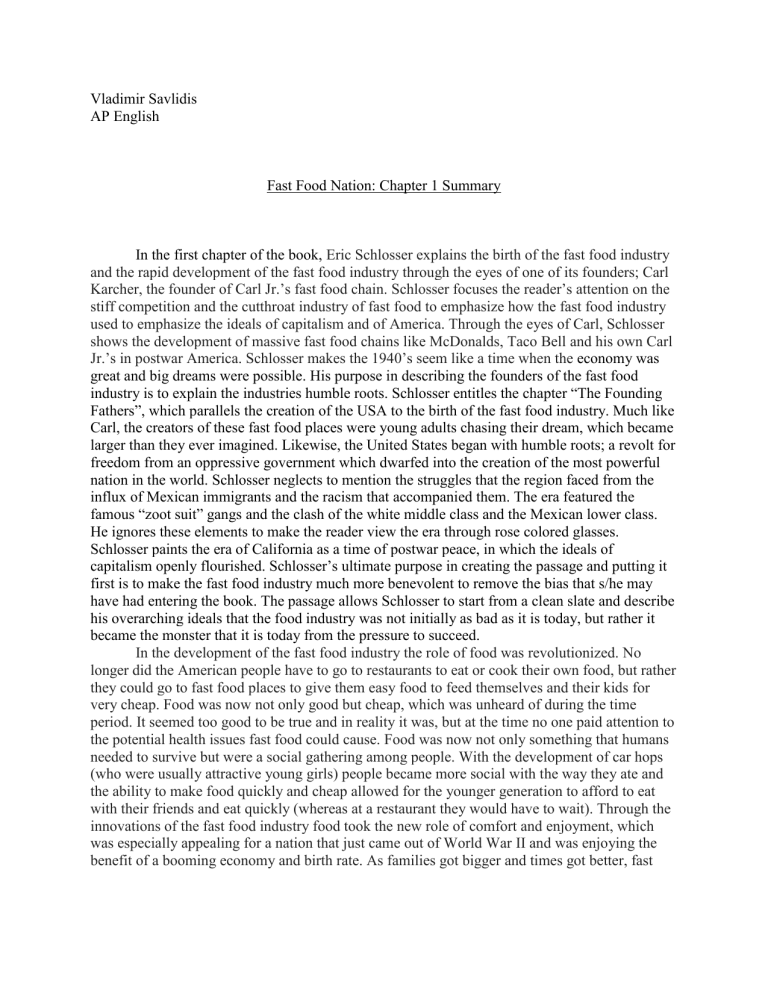
Vladimir Savlidis
Fast Food Nation: Chapter 1 Summary
In the first chapter of the book, Eric Schlosser explains the birth of the fast food industry and the rapid development of the fast food industry through the eyes of one of its founders; Carl
Karcher, the founder of Carl Jr.’s fast food chain. Schlosser focuses the reader’s attention on the stiff competition and the cutthroat industry of fast food to emphasize how the fast food industry used to emphasize the ideals of capitalism and of America. Through the eyes of Carl, Schlosser shows the development of massive fast food chains like McDonalds, Taco Bell and his own Carl
Jr.’s in postwar America. Schlosser makes the 1940’s seem like a time when the economy was great and big dreams were possible. His purpose in describing the founders of the fast food industry is to explain the industries humble roots. Schlosser entitles the chapter “The Founding
Fathers”, which parallels the creation of the USA to the birth of the fast food industry. Much like
Carl, the creators of these fast food places were young adults chasing their dream, which became larger than they ever imagined. Likewise, the United States began with humble roots; a revolt for freedom from an oppressive government which dwarfed into the creation of the most powerful nation in the world. Schlosser neglects to mention the struggles that the region faced from the influx of Mexican immigrants and the racism that accompanied them. The era featured the famous “zoot suit” gangs and the clash of the white middle class and the Mexican lower class.
He ignores these elements to make the reader view the era through rose colored glasses.
Schlosser paints the era of California as a time of postwar peace, in which the ideals of capitalism openly flourished. Schlosser’s ultimate purpose in creating the passage and putting it first is to make the fast food industry much more benevolent to remove the bias that s/he may have had entering the book. The passage allows Schlosser to start from a clean slate and describe his overarching ideals that the food industry was not initially as bad as it is today, but rather it became the monster that it is today from the pressure to succeed.
In the development of the fast food industry the role of food was revolutionized. No longer did the American people have to go to restaurants to eat or cook their own food, but rather they could go to fast food places to give them easy food to feed themselves and their kids for very cheap. Food was now not only good but cheap, which was unheard of during the time period. It seemed too good to be true and in reality it was, but at the time no one paid attention to the potential health issues fast food could cause. Food was now not only something that humans needed to survive but were a social gathering among people. With the development of car hops
(who were usually attractive young girls) people became more social with the way they ate and the ability to make food quickly and cheap allowed for the younger generation to afford to eat with their friends and eat quickly (whereas at a restaurant they would have to wait). Through the innovations of the fast food industry food took the new role of comfort and enjoyment, which was especially appealing for a nation that just came out of World War II and was enjoying the benefit of a booming economy and birth rate. As families got bigger and times got better, fast
food industries appealed to a changing way to eat for a changing generation, unlike anything their parents have seen.
Related documents
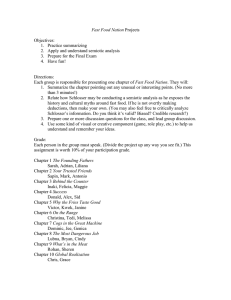
Add this document to collection(s)
You can add this document to your study collection(s)
Add this document to saved
You can add this document to your saved list
Suggest us how to improve StudyLib
(For complaints, use another form )
Input it if you want to receive answer
- Member Login
- Library Patron Login
SUBSCRIBE TO OUR
FREE NEWSLETTERS
Search: Title Author Article Search String:
Reviews of Fast Food Nation by Eric Schlosser
Summary | Excerpt | Reading Guide | Reviews | Read-Alikes | Genres & Themes | Author Bio
Fast Food Nation
The Dark Side of The All American Meal
by Eric Schlosser
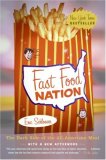
Critics' Opinion:
Readers' Opinion:
- History, Current Affairs and Religion
- Science, Health and the Environment
- Contemporary
Rate this book
Buy This Book
About this Book
- Reading Guide
Book Summary
A groundbreaking work of investigation and cultural history that may change the way America thinks about the way it eats.
Are we what we eat? To a degree both engrossing and alarming, the story of fast food is the story of postwar America. Though created by a handful of mavericks, the fast food industry has triggered the homogenization of our society. Fast food has hastened the malling of our landscape, widened the chasm between rich and poor, fueled an epidemic of obesity, and propelled the juggernaut of American cultural imperialism abroad. That's a lengthy list of charges, but Eric Schlosser makes them stick with an artful mix of first-rate reportage, wry wit, and careful reasoning. Schlosser's myth-shattering survey stretches from the California subdivisions where the business was born to the industrial corridor along the New Jersey Turnpike where many of fast food's flavors are concocted. He hangs out with the teenagers who make the restaurants run and communes with those unlucky enough to hold America's most dangerous job -- meatpacker. He travels to Las Vegas for a giddily surreal franchisers' convention where Mikhail Gorbachev delivers the keynote address. He even ventures to England and Germany to clock the rate at which those countries are becoming fast food nations. Along the way, Schlosser unearths a trove of fascinating, unsettling truths -- from the unholy alliance between fast food and Hollywood to the seismic changes the industry has wrought in food production, popular culture, and even real estate. He also uncovers the fast food chains' efforts to reel in the youngest, most susceptible consumers even while they hone their institutionalized exploitation of teenagers and minorities. Schlosser then turns a critical eye toward the hot topic of globalization -- a phenomenon launched by fast food. Fast Food Nation is a groundbreaking work of investigation and cultural history that may change the way America thinks about the way it eats.
Table of Contents Introduction The American Way 1. The Founding Fathers 2. Your Trusted Friends 3. Behind the Counter 4. Success Meat and Potatoes 5. Why the Fries Taste Good 6. On the Range 7. Cogs in the Great Machine 8. The Most Dangerous Job 9. What’s in the Meat 10. Global Realization Epilogue: Have It Your Way Photo Credits Notes Bibliography Acknowledgments Index
Introduction
CHEYENNE MOUNTAIN SITS on the eastern slope of Colorado’s Front Range, rising steeply from the prairie and overlooking the city of Colorado Springs. From a distance, the mountain appears beautiful and serene, dotted with rocky outcroppings, scrub oak, and ponderosa pine. It looks like the backdrop of an old Hollywood western, just another gorgeous Rocky Mountain vista. And yet Cheyenne Mountain is hardly pristine. One of the nation’s most important military installations lies deep within it, housing units of the North American Aerospace ...
Please be aware that this discussion guide will contain spoilers!
- "Beyond the Book" articles
- Free books to read and review (US only)
- Find books by time period, setting & theme
- Read-alike suggestions by book and author
- Book club discussions
- and much more!
- Just $45 for 12 months or $15 for 3 months.
- More about membership!
Media Reviews
Reader reviews.
Write your own review!
Read-Alikes
- Genres & Themes
If you liked Fast Food Nation, try these:

by Jonathan Miles
Published 2014
About this book
More by this author
A compulsively readable, deeply human novel that examines our most basic and unquenchable emotion: want. With a satirist's eye and a romantic's heart, Miles captures the morass and comedy of contemporary life in all its excess.
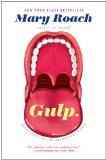
by Mary Roach
The irresistible, ever-curious, and always best-selling Mary Roach returns with a new adventure to the invisible realm we carry around inside.
Books with similar themes
Support bookbrowse.
Join our inner reading circle, go ad-free and get way more!
Find out more

BookBrowse Book Club

Members Recommend

This Strange Eventful History by Claire Messud
An immersive, masterful story of a family born on the wrong side of history.

The Stolen Child by Ann Hood
An unlikely duo ventures through France and Italy to solve the mystery of a child’s fate.
Win This Book

Only the Brave by Danielle Steel
A powerful, sweeping historical novel about a courageous woman in World War II Germany.
Solve this clue:
and be entered to win..
Your guide to exceptional books
BookBrowse seeks out and recommends the best in contemporary fiction and nonfiction—books that not only engage and entertain but also deepen our understanding of ourselves and the world around us.
Subscribe to receive some of our best reviews, "beyond the book" articles, book club info and giveaways by email.
Fast Food Nation

39 pages • 1 hour read
A modern alternative to SparkNotes and CliffsNotes, SuperSummary offers high-quality Study Guides with detailed chapter summaries and analysis of major themes, characters, and more.
Chapter Summaries & Analyses
Introduction-Chapter 2
Chapters 3-4
Chapters 5-6
Chapters 7-8
Chapter 9-Epilogue
Key Figures
Index of Terms
Important Quotes
Essay Topics
Discussion Questions
Chapters 5-6 Chapter Summaries & Analyses
Chapter 5 summary: “why the fries taste good”.
Schlosser continues his journey around the country, this time taking the reader to Idaho. He introduces J. R. Simplot, a former potato farmer turned business tycoon who was the pioneering force behind the frozen french fries McDonald’s and almost all other fast food chains use. Like Ray Kroc and Carl Karcher, Simplot was man from humble origins who relied upon his ingenuity and risk-taking to great effect. At the time Schlosser met Simplot, the man was a billionaire. The development of the frozen french fry heralded a monumental change to the American diet and to American agriculture. Schlosser lays out a history of how potato processing companies became tremendously powerful and the corresponding impact these companies had on individual family farming. Schlosser mentions the “fallacy of composition”—the “mistaken belief that what seems good for an individual will still be good when others do the same thing” (142)—and the way independent farmers used it to justify growing their businesses by introducing expensive new technologies and methods that would ultimately not be profitable when other farmers all did the same thing.

Don't Miss Out!
Access Study Guide Now
Related Titles
By Eric Schlosser
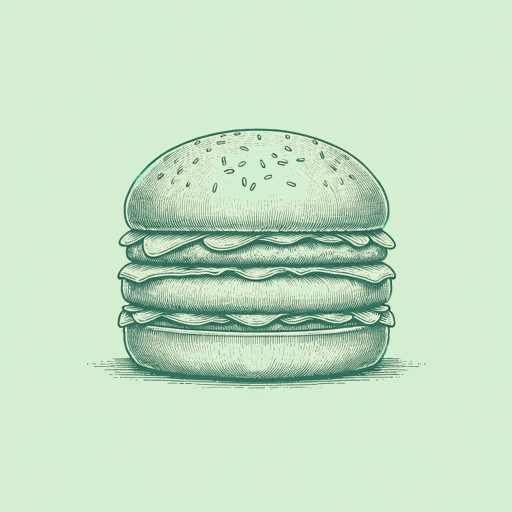
Chew On This: Everything You Don’t Want To Know About Fast Food
Charles Wilson, Eric Schlosser

Reefer Madness
Eric Schlosser
Featured Collections
Business & Economics
View Collection
Challenging Authority
Contemporary Books on Social Justice
Health & Medicine
Journalism Reads
Politics & Government
Required Reading Lists
School Book List Titles
- Share full article
Advertisement
Supported by
Student Opinion
What Is Your Relationship With Fast Food?
Do you love it, hate it or feel something in between?

By Michael Gonchar
Fast food is seemingly everywhere. One can find a McDonald’s, a Chick-fil-A, a Taco Bell, a Wendy’s, a Dunkin’ or a Domino’s, just to name a few of the most popular chains, in towns and cities across the United States and around the world.
What do you think about fast food? Is it something that improves our lives and makes the world a better place? Or is it a bad thing for our health and a negative influence in our communities?
Brian Gallagher begins the article “ Fast Food Forever: How McHaters Lost the Culture War ” by discussing how the fast food industry faced a strong backlash two decades ago, when the film “Super Size Me,” directed by and starring Morgan Spurlock, became a smash hit. He writes:
Following Mr. Spurlock as he ate nothing but McDonald’s for 30 days — and the ill effects that diet had on his health — the film became the high-water mark in a tide of sentiment against fast food. McDonald’s, specifically, became a symbol for the glossy hegemony of American capitalism both at home and abroad. “McJobs” became a term for low-paying, dead-end positions, “McMansions” for garish, oversize houses. In 1992, the political theorist Benjamin Barber used the term “McWorld” as shorthand for emergent neoliberal dominance; seven years later, protesters against the World Trade Organization seemed to agree, launching a newspaper box through a McDonald’s window during the “Battle of Seattle” marches. Two years after that, Eric Schlosser’s “ Fast Food Nation ” was published. A broad indictment of the entire fast-food industry, the best seller accused the industry of being bad for the environment, rife with labor issues, culturally flattening and culinarily fattening.
The article explains that fast food is still thriving 20 years later:
But two decades later, not only is McDonald’s bigger than ever, with nearly 42,000 global locations, but fast food in general has boomed. There are now some 40 chains with more than 500 locations in the United States. Fast food is the second-largest private employment sector in the country, after hospitals, and 36 percent of Americans — about 84 million people — eat fast food on any given day. The three major appeals of fast food remain intact: It’s cheap, it’s convenient and people like the way it tastes.
Mr. Gallagher also discusses the pivotal role that children play for the fast food industry:
Historically, fast-food companies have been very astute about marketing to children, realizing decades ago that creating customers early means creating customers for life. At the peak of his fame in the 1980s, Ronald McDonald was in some countries more recognizable to children than Mickey Mouse. In 2000, 90 percent of children ages 6 to 9 visited a McDonald’s in a given month. But as Frances Fleming-Milici, the director of marketing initiatives at the UConn Rudd Center for Food Policy and Health, put it, “If it’s marketed to children, it’s probably bad for you.” That became increasingly clear in the mid-2000s. Childhood obesity rates had nearly tripled in 25 years, and the public outcry was growing more urgent. A consortium of large food brands, including McDonald’s, Burger King, PepsiCo and Coca-Cola, tried to get out in front of the problem. They formed the Children’s Food and Beverage Advertising Initiative , and the participating corporations self-imposed limits on advertising to children under 13 (later 12). In place of that marketing to children, though, the big fast-food chains have found something arguably more potent, with McDonald’s, as ever, leading the way. “They’re hyperfocusing on what they call fan-favorite moments, trying to essentially identify how we emotionally connect to McDonald’s,” said Kaitlin Ceckowski, who researches fast-food marketing strategies at Mintel, a market research agency. “What ‘human truths’ exist around their brand?”
Students, read the entire article and then tell us:
Do you like to eat fast food? Why, or why not?
Which fast food chains are your favorites — or least favorites? Why?
When was the last time you ate fast food? In a typical month, how often do you eat it?
Do you think fast food chains make your town or city a better place to live? Why, or why not?
The article discusses paid partnerships between Travis Scott and McDonald’s, Megan Thee Stallion and Popeyes, Ice Spice and Dunkin’, and Lil Nas X and Taco Bell. Do these celebrity ad campaigns make you want to eat fast food more? In general, do you think that fast food advertising is effective — especially with children and teenagers? Why, or why not?
Are you concerned about health issues associated with eating too much fast food, such as diabetes and obesity? Do you think more should be done — by parents, companies or the government — to help limit how much fast food children eat? Why, or why not?
Students 13 and older in the United States and Britain, and 16 and older elsewhere, are invited to comment. All comments are moderated by the Learning Network staff, but please keep in mind that once your comment is accepted, it will be made public and may appear in print.
Find more Student Opinion questions here. Teachers, check out this guide to learn how you can incorporate these prompts into your classroom.

Fast Food Nation
Eric schlosser, ask litcharts ai: the answer to your questions.

IMAGES
VIDEO
COMMENTS
Analysis. Schlosser begins his story with Carl Karcher, the eventual founder of Carl's Jr. fast-food restaurants. Karcher was born to a large German-Catholic family in northern Ohio, in 1917, and moved at the age of 20 to Anaheim, where his uncle Ben had offered him a job at Karcher's Feed and Seed, a business Ben owned.
Chapter Summaries Chart. Chapter. Summary. Epigraph and Introduction. The book's epigraph, "A savage servility slides by on grease," is a quotation from the poem "For the Union Dead" by Robe... Read More. Part 1, Chapter 1. This chapter depicts the rise of fast food restaurants through the "rags to riches" life story of entrepreneur Carl N. K...
Chapter 1 opens with discussion of Carl N. Karcher, one of fast food's pioneers. Carl was born in 1917 in Ohio. He quit school after eighth grade and spent long hours farming with his father. When he was twenty years old, his uncle offered him a job in his Feed and Seed store in Anaheim, CA. Carl moved out to California, where he met his wife ...
Fast Food Nation Summary. Eric Schlosser's Fast Food Nation is an attempt to describe how American eating and food-production patterns have changed since World War Two. Schlosser charts this transformation by tracking many different people: fast-food employees at franchises, and well-paid executives at fast-food conglomerates; ranchers and ...
Fast Food Nation Summary Chapter 1: SoCal Origins. The fast food industry has its roots in the risk-taking, unconventional ideas of a handful of entrepreneurs. A combination of US public policy choices and broader macroeconomic trends fostered an ideal business climate in Southern California for their success and laid the groundwork for an economic transformation of the region—one that would ...
Fast Food Nation: The Dark Side of the All-American Meal is a 2001 nonfiction book by Eric Schlosser that investigates the business practices of the American fast food industry and the associated agricultural industries that supply it. Following the precedent of Upton Sinclair's famous 1906 work The Jungle, Schlosser provides readers with a glimpse into the questionable ethics of these large ...
Fast Food Nation Summary. These notes were contributed by members of the GradeSaver community. We are thankful for their contributions and encourage you to make your own. Written by Micola Magdalena and other people who wish to remain anonymous. Eric Schlosser begins his book by explaining why he chose to focus on one group of cities in America ...
Entrepreneurs from throughout the nation came to observe the McDonald's phenomenon. During this period many of the fast-food places that remain today were started: Taco Bell, Dunkin' Donuts, Wendy's, Domino's, and Kentucky Fried Chicken. During the Arab oil embargo of 1973, fast-food restaurants underwent a bad scare, but they recovered.
Chapter 1 Summary Chapter 2 Summary ... Reading Eric Schlosser's groundbreaking study Fast Food Nation, one learns that just about everything is. Schlosser uncovers a history of corruption ...
Fast Food Nation takes up, in some sense, the path-breaking writings of Upton Sinclair, whose 1906 novel The Jungle first detailed—exquisitely and, to some, repugnantly—the terrible conditions of Chicago meatpacking plants. Sinclair's work, as Schlosser notes in his book, went on to spur Theodore Roosevelt and the Congress to enact regulation in support of hygienic meatpacking practices ...
Complete summary of Eric Schlosser's Fast Food Nation: The Dark Side of the All-American Meal. eNotes plot summaries cover all the significant action of Fast Food Nation: The Dark Side of the All ...
Start your 48-hour free trial to unlock this study guide. You'll also get access to more than 30,000 additional guides and more than 350,000 Homework Help questions answered by our experts.
Fast Food Nation: Chapter 1 Summary . In the first chapter of the book, Eric Schlosser explains the birth of the fast food industry and the rapid development of the fast food industry through the eyes of one of its founders; Carl . Karcher, the founder of Carl Jr.'s fast food chain. Schlosser focuses the reader's attention on the stiff ...
Fast food has hastened the malling of our landscape, widened the chasm between rich and poor, fueled an epidemic of obesity, and propelled the juggernaut of American cultural imperialism abroad. That's a lengthy list of charges, but Eric Schlosser makes them stick with an artful mix of first-rate reportage, wry wit, and careful reasoning.
Americans spend billions of dollars each year on fast food, and only a few corporations control most of the nation's food supply. The service economy, which includes the restaurant industry, creates most new jobs, a large number of them in the fast food sector. In fact, Schlosser says "an estimated one out of every eight workers in the United ...
The meat industry has introduced deadly pathogens into the American diet. Fast food corporations work with government allies to oppose worker safety, food safety, and minimum wage laws. Eric Schlosser will use evidence, including statistics and worker narratives, to prove the claims he makes in the Introduction. Chapter Summaries Chapter 1.
Eric Schlosser begins his account of the American fast food industry by focusing on one region of the United States in particular: Colorado's "Front Range," or a group of cities including Denver, Colorado Springs, and Fort Collins, just east of the Rockies. Schlosser believes that this expanding, suburbanized region of the Mountain West is an emblem of late 20th-century economic growth ...
Key Takeaways. This chapter analyzes the role of marketing, advertising, and corporate sponsorship in fast food. The chapter also develops the connection between the Disney and McDonald's empires. The Ray A. Kroc museum and McDonald's managerial training center (Hamburger University) illustrate the "Disneyesque" culture of the chain and its ...
Page Number and Citation: 261. Cite this Quote. Explanation and Analysis: Unlock with LitCharts A +. [At the fast food counter], think about where the food came from, about how and where it was made, about what is set in motion by every single fast food purchase, the ripple effect near and far, think about it.
Chapter 5 Summary: "Why the Fries Taste Good". Schlosser continues his journey around the country, this time taking the reader to Idaho. He introduces J. R. Simplot, a former potato farmer turned business tycoon who was the pioneering force behind the frozen french fries McDonald's and almost all other fast food chains use.
Fast food is the second-largest private employment sector in the country, after hospitals, and 36 percent of Americans — about 84 million people — eat fast food on any given day. The three ...
Fast food franchisees invest as much as $1.5 million up front, seeking a low-risk way to go into business for themselves. But franchising is risky. Up to 38% of franchises fail within five years. Franchisees are not covered by consumer protection laws. Fast food chains may take advantage of their franchisees by "encroachment" or putting two ...
Analysis. Schlosser begins the chapter by describing an actual visit to a meatpacking plant, "one of the nation's largest," "somewhere in the High Plains.". The journey through the plant begins normally enough, with very small pieces of meat not dissimilar from what one might see "in the supermarket.". But as Schlosser moves ...
Analysis. Schlosser traces the life story of another figure, one of the most famous and richest men in the state of Idaho— J. R. Simplot, whose potato empire would go on to change the ways potatoes were consumed in the US. Simplot was born in Iowa in 1909, and as a young man worked for a landlord named Lindsay Maggart, and the two of them, in ...